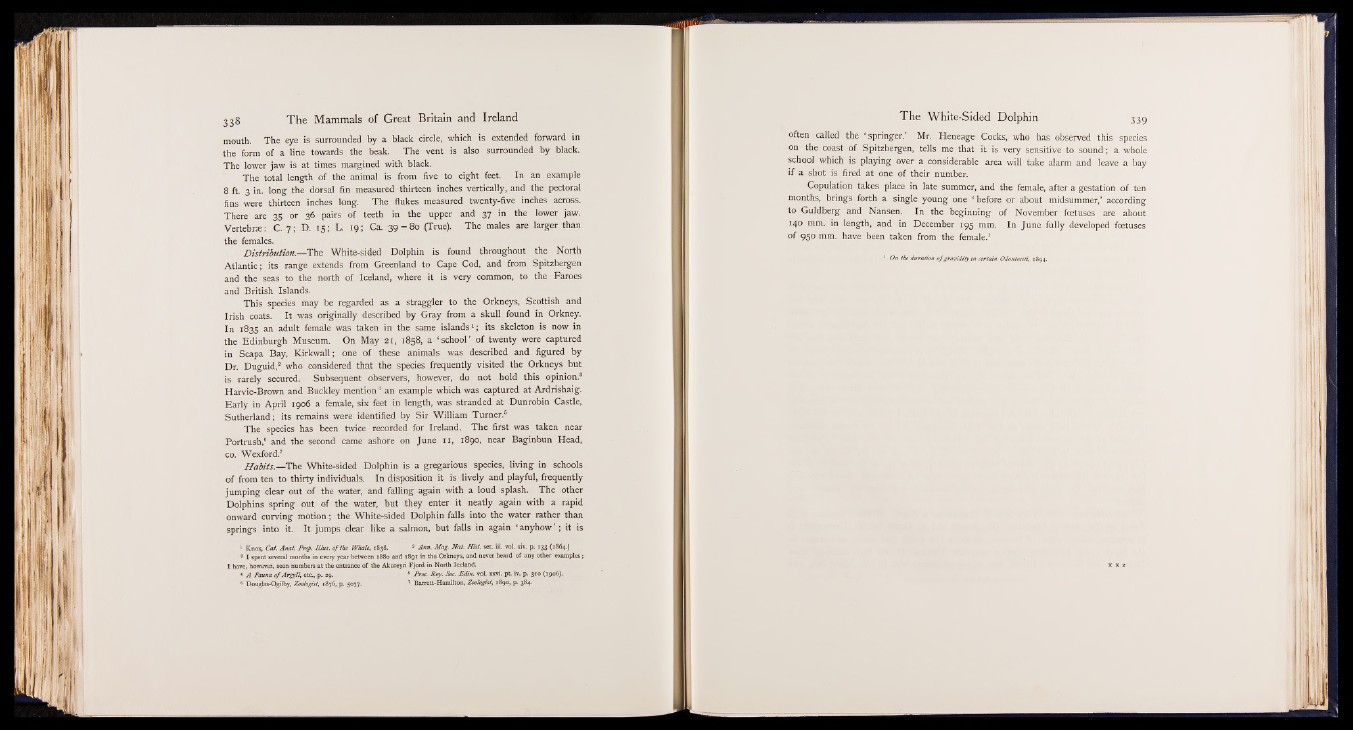
mouth. The eye is surrounded by a black circle, which is extended forward in
the form of a line towards the beak. The vent is also surrounded by black.
The lower jaw is at times margined with black.
The total length of the animal is from five to eight feet. In an example
8 ft. 3 in. long the dorsal fin measured thirteen inches vertically, and the pectoral
fins were thirteen inches long. The flukes measured twenty-five inches across.
There are 35 or 36 pairs of teeth in the upper and 37 in the lower jaw.
Vertebra: C. 7; D. 15; L. 19; Ca. 39 = 80 (True). The males are larger than
the females.
Distribution.— The White-sided Dolphin is found throughout the North
A t la n tS its range extends from Greenland to Cape Cod, and from Spitsbergen
and the seas to the north of Iceland, where it is very common, to the Faroes
and British Islands.
This species may be regarded as a straggler to the Orkneys, Scottish and
Irish coats. It was originally described by Gray from a skull found in Orkney.
In 1835 an adult female was taken in the same islands1 ; its skeleton is now in
the Edinburgh Museum. On May 21, 1858, a ‘ school’ of twenty were captured
in Scapa Bay, Kirkwall; one of these animals was described and figured by
Dr. Duguid,3 who considered that the species frequently visited the Orkneys but
is rarely secured. Subsequent observers, however, do not hold this opinion.8
Harvie-Brown and Buckley mention' an example which was captured at Ardrishaig.
Early in April 1906 a female, six feet in length, was stranded at Dunrobin Castle,
Sutherland;' its remains were identified by Sir William Turner.6
The species has been twice recorded for Ireland. The first was taken near
Portrush,6 and the second came ashore on June 11, 1890, near Baginbun Head,
co. Wexford.7
H abits.— The White-sided Dolphin is a gregarious species, living in schools
of from ten to thirty individuals. In disposition it is lively and playful, frequently
jumping clear out of the water, and falling again with a loud splash. The other
Dolphins spring out of the water, but they enter it neatly again with a rapid
onward curving motion; the White-sided Dolphin falls into the water rather than
springs into it. It jumps clear like a salmon, but falls in again ‘ anyhow ’ ; it is
1 Knox, Cat. Anat. Prep. Ulus, o f the Whale, 1838. * Ann. Mag. Nat. H ist. set. iii. vol. xiv. p. 133 {1864.)
8 I spent several months in every year between 1880 and 1891 in the Orkneys, and never heard of any other examples;
I have, however, seen numbers at the entrance of the Akureyri Fjord in North Iceland.
* A Fauna o f Argyll, eta, p. 29. 6 Proc. Roy. Soc. Edin. voL xxvi. p t iv. p. 310 (1906).
6 Douglas-Ogilby, Zoologist, 1876, p. 5077. 7 Barrett-Hamilton, Zoologist, 1890, p. 384.
often called the ‘ springer.’ Mr. Heneage Cocks, who has observed this species
on the coast of Spitzbergen, tells me that it is very sensitive to sound; a whole
school which is playing over a considerable area will take alarm and leave a bay
if a shot is fired at one of their number.
Copulation takes place in late summer, and the female, after a gestation of ten
months, brings forth a single young one ‘ before or about midsummer,’ according
to Guldberg and Nansen. In the beginning of November foetuses are about
140 mm. in length, and in December 195 mm. In June fully developed foetuses
of 950 mm. have been taken from the female.1
1 On the duration o f gravidity in certain Odontoceti, 1894.